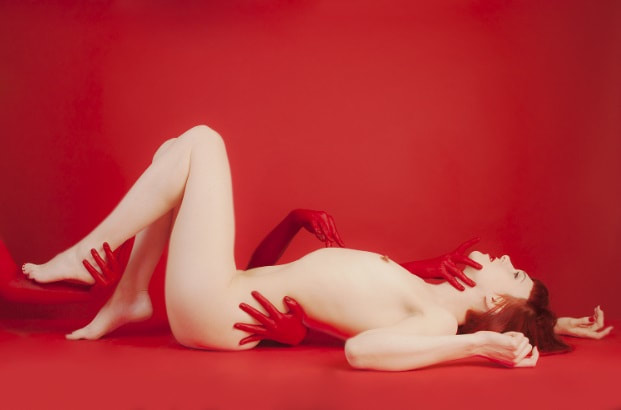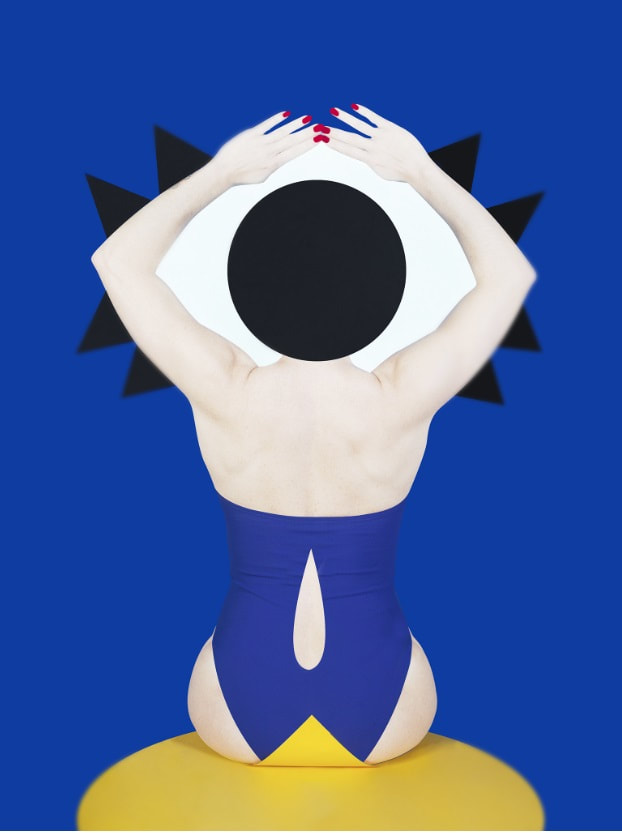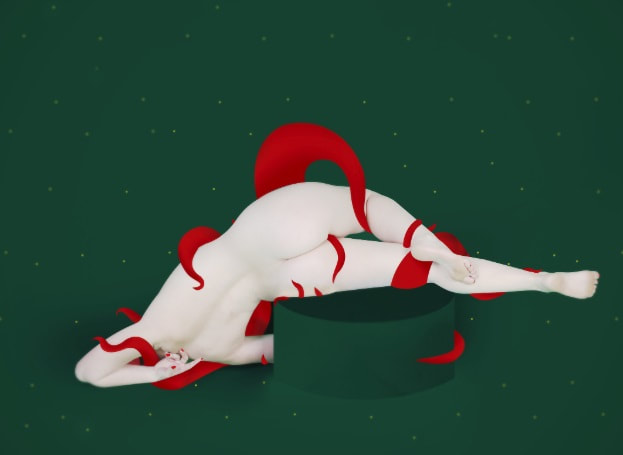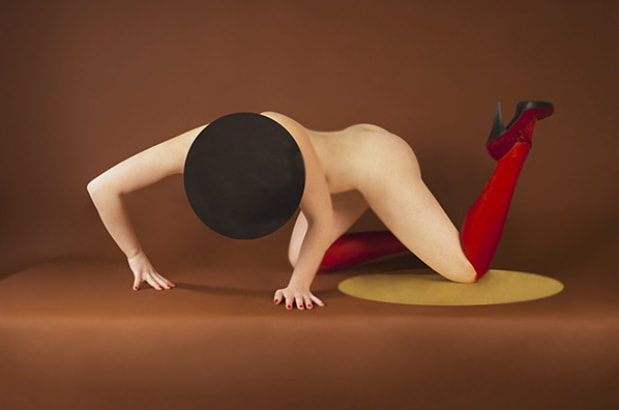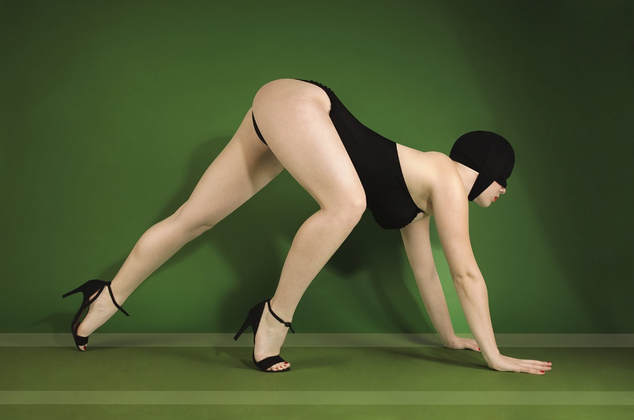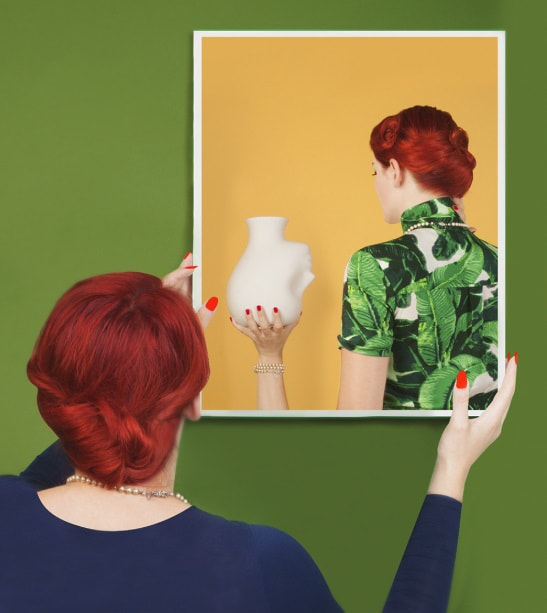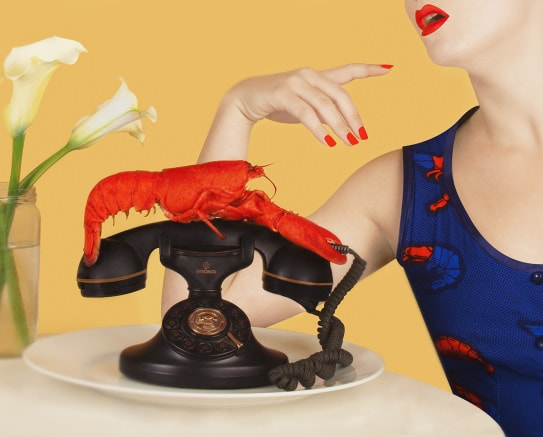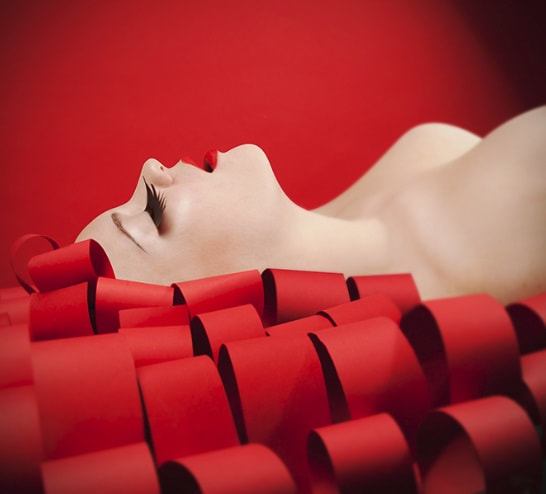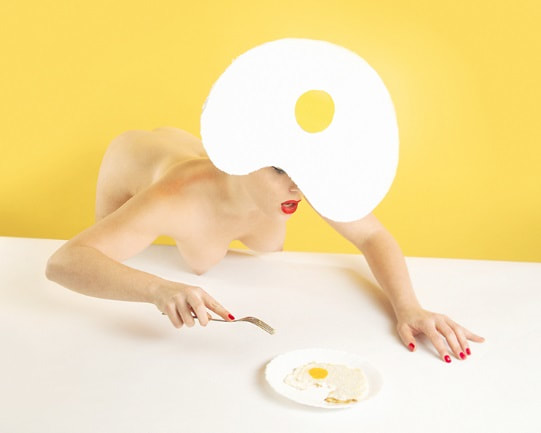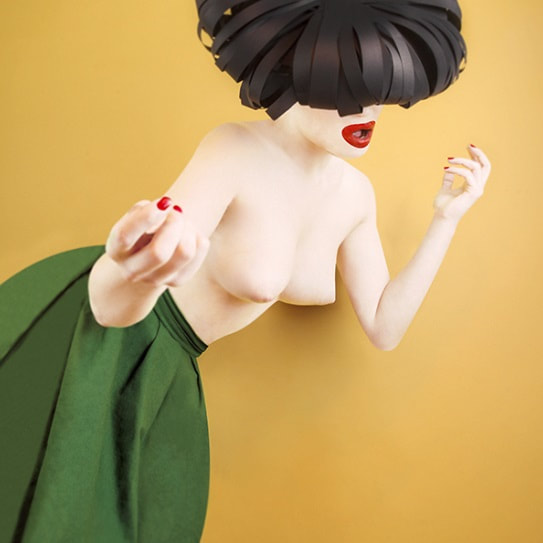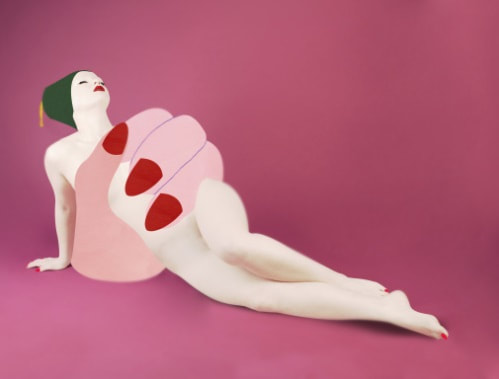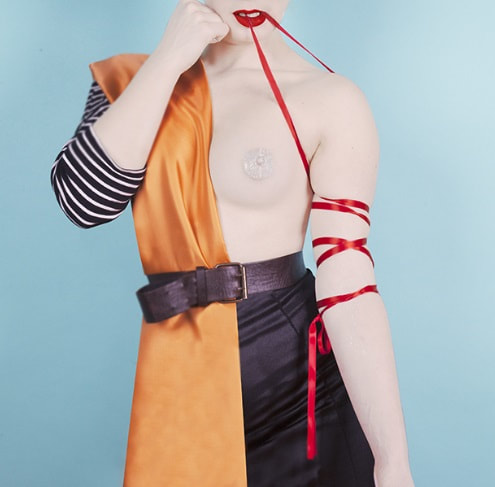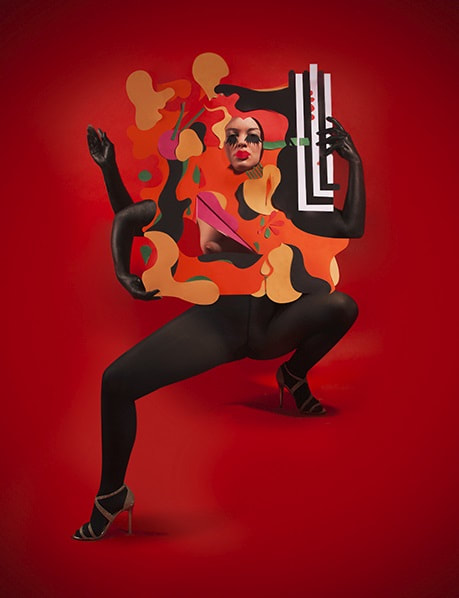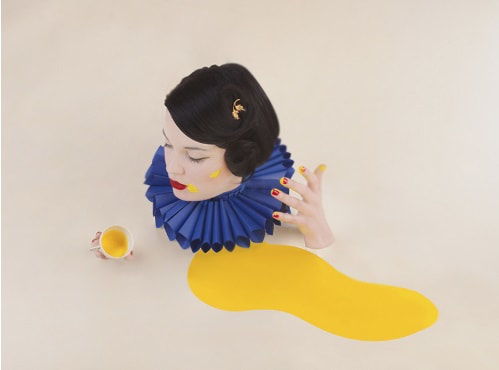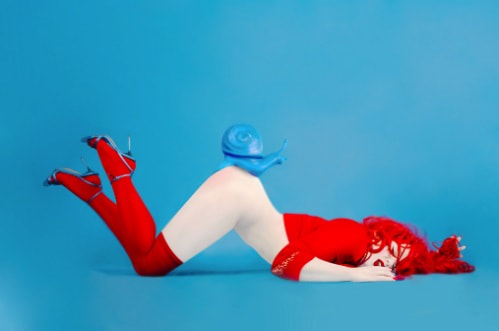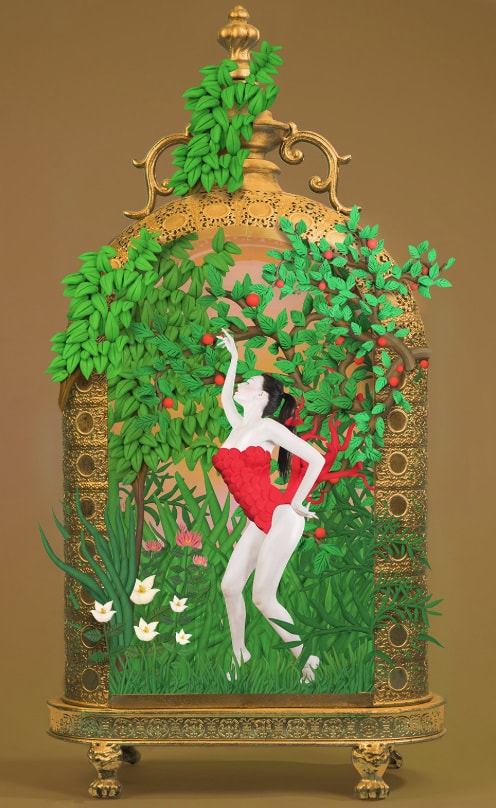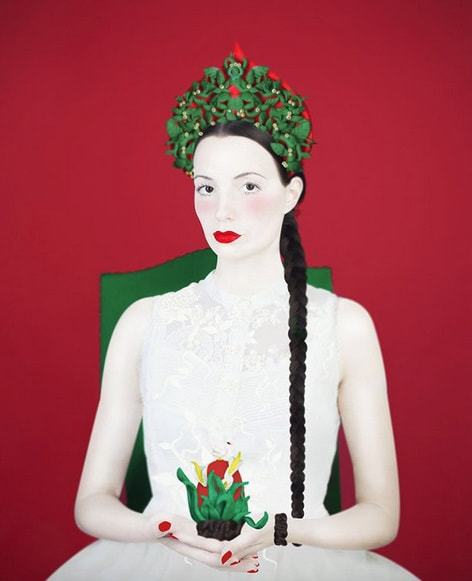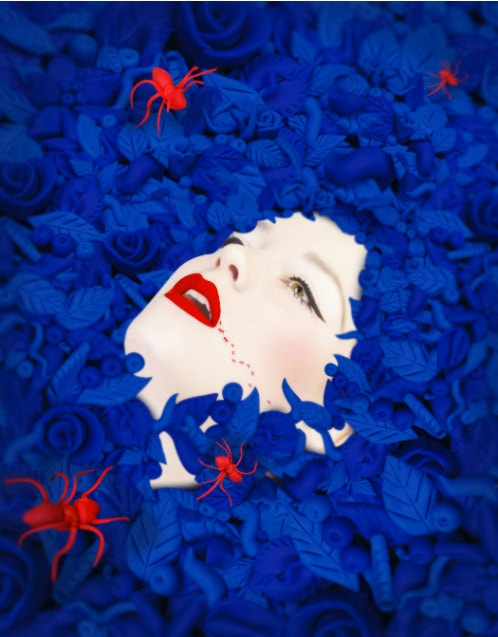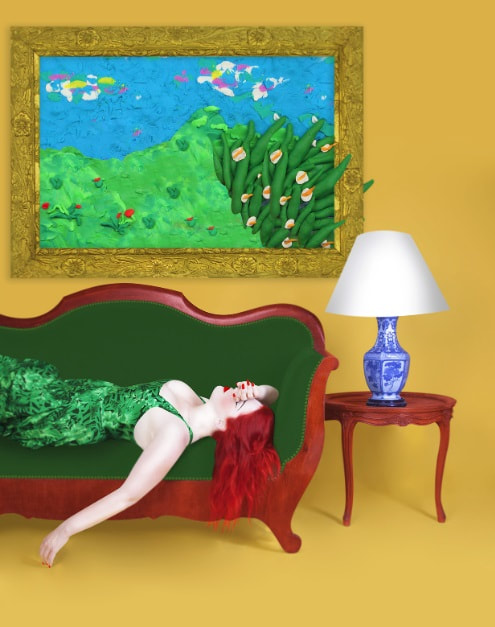Nathalie De Zan
DIURNAL CHIMERAS
"A dog, your daily life, a tornado, sodium, your eyelids ... heavy, burdensome as a stem, you're in a cellar, it's hot ... in a hypnagogic state ... you fall asleep. The After the After After After. Horri. Horri.............................. I'm here to you, the fantasies of my imagination at the time of falling asleep, a kind of surrealist statement of a frequent aspect in my existence in the form of diurnal arcana. from which unexplored areas seem to be absent, it is a fragmented area whose boundaries are imaginary but at the same time is a source of anxiety and an invitation to go beyond them.
"It will be possible to create as many things as possible for a body to be fragmented. "Appreciating corporeality raises the question of the links between the body and its representation, between the lived body and the fictitious body, and the 'mirror stage', according to Jacques Lacan. Here, as in the act of creating, the inhuman is to the work what the work is to the human.
Dealing with the human, fiction demands the expression of what a priori derives from its opposite and concretizes the transgression of limits that distinguish the norm from the unconventional, the pure from the impure. Fiction approaches the boundaries of the body, whether pictorial, physical or symbolic, and at the same time, the experience of formlessness, be it the ultimate transgression of the principle of imitation,
supposed to govern creation.
Red Nightmare - 47 x 70 cm - 3ex
SAY CHEEEESE
Naked, dressed, bent, transformed ... Nathalie De Zan manipulates the body in surrealistic stagings"Born in Toulouse, Nathalie De Zan is a multimedia author since 8 years. Even if her favorite field is photography, she uses all sorts of mediums in her creative process to achieve her aesthetic goals: video, graphics, music, scenography, garment creation, origami ...
She works mainly on the bound body to space and the intimate in provocative and dreamlike situations. The body is for her a way to develop analogies between artistic and physical processes. The goal is to question the status of the body in the face of the various pressures of our modern world.
She creates syncretic chimeras with the help of metaphors and symbols that she questions constantly.
Naked, dressed, bent, transformed ... Nathalie De Zan manipulates the body in surrealistic stagings"Born in Toulouse, Nathalie De Zan is a multimedia author since 8 years. Even if her favorite field is photography, she uses all sorts of mediums in her creative process to achieve her aesthetic goals: video, graphics, music, scenography, garment creation, origami ...
She works mainly on the bound body to space and the intimate in provocative and dreamlike situations. The body is for her a way to develop analogies between artistic and physical processes. The goal is to question the status of the body in the face of the various pressures of our modern world.
She creates syncretic chimeras with the help of metaphors and symbols that she questions constantly.
Graphic eyes - 50 x 60 cm - 3ex
This is art
This is the art in question, and it is written on all the rotundas of the world, engraved in marble: Sculpture, Painting, Engraving and Architecture, with Nathalie De Zan and there is now the Pure Body . Purity of a moment frozen, a time bound by invisible silk cords, attached to chains of velvet invisible and faint. An undetectable and elusive bondage, without mooring or punishment, with an incredible boldness. A faceless bondage that assures and assumes and frees the body. By hiding the muzzle whose disturbing physiognomy would direct our gaze, we clearly distinguish an erotic hanging, a naked and avowable gesture, in which all curvatures dash in a space of mysterious light.
A fiery body of beauty, distinguished, sumptuous and flamboyant, he invokes the pagan goddesses and the kind of the most majestic human being: the woman. A body neither retouched nor modified in its essence, only a digital caress touches the photographic grain, because this is also photography. The framing and the paper support become a hymn to the mysterious character of femininity. Undetectable gymnastic and geometrical figures, balance in a live dance and stabilize and seem to rest.
Under this desired anonymity, it reveals all the body, an idol, a light mass whose constraints of gravity initiate issues of the base forever disappeared. It is a fixed and fleeting masterful symphony, the 10th of Beethoven ever written, never composed only here before our eyes. We then see and listen to this filled body that sinks and drinks forbidden pleasure.
Only a capillary fire oscillates on the prints and excites our pupils, a roaring flame, an incandescent hair. Is this nebulous mane that of Red Hair? Iconic figure and imaginary heroine, the faithful fighter alongside Storm. It is a storm with ivory legs, muscles tense and rested like those of Barbarella leafless. A blooming warrior who seems to rave about romantic amazon. Branded with a hot iron, our most shameful dreams are out of breath before the exhibition of the faded fleece, no desperate horsehair, it is a hymn to joy, unchained ...
This brilliant exposure in a radiant light transmutes the body in a dazzling wrap and sparkles the corpus to the erased identity. He reveals to us the secret of female anatomy. A photographic moment with the amorous movement, the assembled flesh, an evanescent skin project us in front of a confusing eroticism, just a fatal illusion with the light colors thanks to the electronic filters and emanates thus a back-passed lighting. Photographic or love filters, they seduce us, woo us, captivate us.
A Cokin filter, rogue, exposes an erotic ritual whose vibrations are so many electroshocks and burn our epidermis. We also find a Lynchean strangeness, cinematographic, yet this frozen moment seems to tremble with emotions and mystery. Fantastic and skillful, the chains and the cords disappear and it is our desires, our fantasies, our desires which attach, grant, cord, tie, tighten to conquer and to seduce this unshakable body. This stupefied body that waves and sways between earth and air between air and sea.
A savory levitation sacrifices and exalts the body, hammering it under the eulogy of forgotten Idols. Nathalie De Zan, like the Etruscan goddess Thesan, combines fantasy fertility and vagabond sexuality as a hunter of wild and invisible animals. An exacerbated nature where virginity is out of place. Aphrodite mates with Persephone and gives birth to a vegetation and a nature with the most carnal senses. There is magic in these suspended bodies, or rather hanged to an immaterial gallows, to the elusive executioner.
This body, at least this idol as Bastet, cat goddess or Hathor, personify the principles of love and beach on a smooth sand beach near Sothis fertilizing the soil. Assembly of organs, substance of anatomy, the eulogy of feminine happiness, fantasy of self attached to the moods of the male and female evil spirit. A body jostled and manipulated under the orders of an invisible evil choreographer. It brings out our most unfathomable questions and gives rise to permanent doubts. Unified forms, kneaded towards the body abstraction and fluid and enjoying an ecclesiastical nudity.
Praise of feminine happiness, like an antique statuette, Poetess and witch with abundant rainbows, this idol suppresses chastity,
it becomes a totem, a trophy.
The mute pause of the cliché submits the model as a freed slave in front of a spectator with the master's gaze, it is a domineering lover, this philosopher amphitryon. No possibility of touching or caressing this body hanging from an imaginary gallows. Do they take pleasure? Dominated by action, who enslaves and tames? Who is the slave? The answer is certainly in the skylight and the vision is where the lust of the sculptor, the painter, the engraver and the architect resonates. Pure body with attentive and troubled eyes, she is an irrefutable statue, a caryatid with glitzy and lively sins, a new allegory of freedom, even if it is hanged ... it triumphs.
This is the art in question, and it is written on all the rotundas of the world, engraved in marble: Sculpture, Painting, Engraving and Architecture, with Nathalie De Zan and there is now the Pure Body . Purity of a moment frozen, a time bound by invisible silk cords, attached to chains of velvet invisible and faint. An undetectable and elusive bondage, without mooring or punishment, with an incredible boldness. A faceless bondage that assures and assumes and frees the body. By hiding the muzzle whose disturbing physiognomy would direct our gaze, we clearly distinguish an erotic hanging, a naked and avowable gesture, in which all curvatures dash in a space of mysterious light.
A fiery body of beauty, distinguished, sumptuous and flamboyant, he invokes the pagan goddesses and the kind of the most majestic human being: the woman. A body neither retouched nor modified in its essence, only a digital caress touches the photographic grain, because this is also photography. The framing and the paper support become a hymn to the mysterious character of femininity. Undetectable gymnastic and geometrical figures, balance in a live dance and stabilize and seem to rest.
Under this desired anonymity, it reveals all the body, an idol, a light mass whose constraints of gravity initiate issues of the base forever disappeared. It is a fixed and fleeting masterful symphony, the 10th of Beethoven ever written, never composed only here before our eyes. We then see and listen to this filled body that sinks and drinks forbidden pleasure.
Only a capillary fire oscillates on the prints and excites our pupils, a roaring flame, an incandescent hair. Is this nebulous mane that of Red Hair? Iconic figure and imaginary heroine, the faithful fighter alongside Storm. It is a storm with ivory legs, muscles tense and rested like those of Barbarella leafless. A blooming warrior who seems to rave about romantic amazon. Branded with a hot iron, our most shameful dreams are out of breath before the exhibition of the faded fleece, no desperate horsehair, it is a hymn to joy, unchained ...
This brilliant exposure in a radiant light transmutes the body in a dazzling wrap and sparkles the corpus to the erased identity. He reveals to us the secret of female anatomy. A photographic moment with the amorous movement, the assembled flesh, an evanescent skin project us in front of a confusing eroticism, just a fatal illusion with the light colors thanks to the electronic filters and emanates thus a back-passed lighting. Photographic or love filters, they seduce us, woo us, captivate us.
A Cokin filter, rogue, exposes an erotic ritual whose vibrations are so many electroshocks and burn our epidermis. We also find a Lynchean strangeness, cinematographic, yet this frozen moment seems to tremble with emotions and mystery. Fantastic and skillful, the chains and the cords disappear and it is our desires, our fantasies, our desires which attach, grant, cord, tie, tighten to conquer and to seduce this unshakable body. This stupefied body that waves and sways between earth and air between air and sea.
A savory levitation sacrifices and exalts the body, hammering it under the eulogy of forgotten Idols. Nathalie De Zan, like the Etruscan goddess Thesan, combines fantasy fertility and vagabond sexuality as a hunter of wild and invisible animals. An exacerbated nature where virginity is out of place. Aphrodite mates with Persephone and gives birth to a vegetation and a nature with the most carnal senses. There is magic in these suspended bodies, or rather hanged to an immaterial gallows, to the elusive executioner.
This body, at least this idol as Bastet, cat goddess or Hathor, personify the principles of love and beach on a smooth sand beach near Sothis fertilizing the soil. Assembly of organs, substance of anatomy, the eulogy of feminine happiness, fantasy of self attached to the moods of the male and female evil spirit. A body jostled and manipulated under the orders of an invisible evil choreographer. It brings out our most unfathomable questions and gives rise to permanent doubts. Unified forms, kneaded towards the body abstraction and fluid and enjoying an ecclesiastical nudity.
Praise of feminine happiness, like an antique statuette, Poetess and witch with abundant rainbows, this idol suppresses chastity,
it becomes a totem, a trophy.
The mute pause of the cliché submits the model as a freed slave in front of a spectator with the master's gaze, it is a domineering lover, this philosopher amphitryon. No possibility of touching or caressing this body hanging from an imaginary gallows. Do they take pleasure? Dominated by action, who enslaves and tames? Who is the slave? The answer is certainly in the skylight and the vision is where the lust of the sculptor, the painter, the engraver and the architect resonates. Pure body with attentive and troubled eyes, she is an irrefutable statue, a caryatid with glitzy and lively sins, a new allegory of freedom, even if it is hanged ... it triumphs.
Tako - 60 x 70 cm - 2ex
Andalusian - 51 x 33 cm - 2ex
Green race - 60 x 90 cm - 3ex
Abyss portrait - 30 x 26 cm - 3ex
Aphrodisiac lobster - 25 x 20 cm - 3ex
Red Ophelia - 65 x 58 cm - 2ex
Egg - 66 x 53 cm - 3ex
Clown - 66 x 53 cm - 3ex
Hand - 57 x 43 cm - 2ex
Portrait on the red strap - 60 x 60 cm - 3ex
- 47 x 62 cm - 3ex
White snow - 13 x 17 cm - 3ex
The snail - 50x76cm- 3ex
PLASTICINE
GAIT
Chronologically following the Diurnal Chimeras, these Plasticines succeed and derive thematically from this work, the freedoms given to these latest creations have allowed the artist to lead to the technical development of his Plasticines (shaping shapes and decorations based on modeling clay, studio photography and digital editing). Introducing unequivocally this unlimited series, Popescu's visit at the time of the nap: It is with this self-portrait an invitation to travel, to dream, in an approach quite similar to that of the Romanticism of the nineteenth century. exoticism, a deliberately naive rather than scholarly way of evoking its subject (whether exotic or mythological), although, as its title indicates, the artist makes direct reference to the illustrator Ana Popescu or declination to the artist Pop Art David Hockney.
After all, would not it be what Nathalie De Zan is looking for in this proposal for escape, the transgression of technical and artistic limits? Naturally following the bed of his ramblings, one finds oneself lost in this luxuriant evocation of a Douanier Rousseau with Le Petit Jardin aux plasticines.
Here, one penetrates a little further into the work (represented by the "natural" material to be modeled) to better transcend the artistic currents. In the idea of accumulation of small elements, including floral and plant, we find, as was indeed the case with painters and engravers of the nineteenth, an inspiration at the level of volumes and perspectives of the illuminations of the first Renaissance, such as the Strawberry Madonna by the Master of the Paradise Garden in Frankfurt, or the mixture of the two worlds in The Annunciation / Adam and Eve in the back Fra Angelico's plan with the detail of the small flowers and also the work of the arches and the perspective that one finds in Splendor and martyr Angelica. It is at the same time that Nathalie De Zan is interested in the "significant perspective" which consists of giving the characters a size proportional to their symbolic importance and objects and buildings a form that suits the meaning associated with them.
What is interesting to grasp is how his plastic work derives from it since once the scene is modeled and erected, the artist brings his character into play, it is a question of symbolically staging a mythological episode. The characters are properly assembled over the background, thus respecting the symbolic hierarchy of the character on the landscape and on the objects with which it is associated: an association of the "big" (the model photographed) on the "little" ( the modeled landscape).
With Splendor and Martyr Angelica, we can not help but think of the naked figure "goiter" of Roger delivering Angélique d'Ingres, the latter sectioned double reference since the knight and the monster will serve them to Saint -Drac or Triumph on the snake artist (which also evokes the red horse version of 1856 by Eugène Delacroix). In Saint-Drac or the Triumph on the snake artist, One wonders if this snake-like monster would not symbolize the diurnal chimeras considered inferior today by the artist.
This is a motive that has become a recurring motif in the history of art, first with Saint-Georges slaying the dragon in the Middle Ages, recovered by Uccello, Rubens and Raphael, who became Roger delivering Angelique, which will then be declined by many romantic engravers such Doré, Böcklin and Redon. Here, the rider sits the dragon at the same time as he kills Angelica. The observer can see a reversal of roles and a revenge of the artist on the feudalism of cultural institutions with the little soldier of the State a Knight Drac brandishing the handle as a stronghold to annihilate the artist the way in which the great religious authorities used Crusaders to guarantee their base.
Chronologically following the Diurnal Chimeras, these Plasticines succeed and derive thematically from this work, the freedoms given to these latest creations have allowed the artist to lead to the technical development of his Plasticines (shaping shapes and decorations based on modeling clay, studio photography and digital editing). Introducing unequivocally this unlimited series, Popescu's visit at the time of the nap: It is with this self-portrait an invitation to travel, to dream, in an approach quite similar to that of the Romanticism of the nineteenth century. exoticism, a deliberately naive rather than scholarly way of evoking its subject (whether exotic or mythological), although, as its title indicates, the artist makes direct reference to the illustrator Ana Popescu or declination to the artist Pop Art David Hockney.
After all, would not it be what Nathalie De Zan is looking for in this proposal for escape, the transgression of technical and artistic limits? Naturally following the bed of his ramblings, one finds oneself lost in this luxuriant evocation of a Douanier Rousseau with Le Petit Jardin aux plasticines.
Here, one penetrates a little further into the work (represented by the "natural" material to be modeled) to better transcend the artistic currents. In the idea of accumulation of small elements, including floral and plant, we find, as was indeed the case with painters and engravers of the nineteenth, an inspiration at the level of volumes and perspectives of the illuminations of the first Renaissance, such as the Strawberry Madonna by the Master of the Paradise Garden in Frankfurt, or the mixture of the two worlds in The Annunciation / Adam and Eve in the back Fra Angelico's plan with the detail of the small flowers and also the work of the arches and the perspective that one finds in Splendor and martyr Angelica. It is at the same time that Nathalie De Zan is interested in the "significant perspective" which consists of giving the characters a size proportional to their symbolic importance and objects and buildings a form that suits the meaning associated with them.
What is interesting to grasp is how his plastic work derives from it since once the scene is modeled and erected, the artist brings his character into play, it is a question of symbolically staging a mythological episode. The characters are properly assembled over the background, thus respecting the symbolic hierarchy of the character on the landscape and on the objects with which it is associated: an association of the "big" (the model photographed) on the "little" ( the modeled landscape).
With Splendor and Martyr Angelica, we can not help but think of the naked figure "goiter" of Roger delivering Angélique d'Ingres, the latter sectioned double reference since the knight and the monster will serve them to Saint -Drac or Triumph on the snake artist (which also evokes the red horse version of 1856 by Eugène Delacroix). In Saint-Drac or the Triumph on the snake artist, One wonders if this snake-like monster would not symbolize the diurnal chimeras considered inferior today by the artist.
This is a motive that has become a recurring motif in the history of art, first with Saint-Georges slaying the dragon in the Middle Ages, recovered by Uccello, Rubens and Raphael, who became Roger delivering Angelique, which will then be declined by many romantic engravers such Doré, Böcklin and Redon. Here, the rider sits the dragon at the same time as he kills Angelica. The observer can see a reversal of roles and a revenge of the artist on the feudalism of cultural institutions with the little soldier of the State a Knight Drac brandishing the handle as a stronghold to annihilate the artist the way in which the great religious authorities used Crusaders to guarantee their base.
The plasticine gardens - 50 x 60 cm - 3ex
with red lips - 50 x 60 cm - 3ex
blue flowers and red ants - 60 x 50 cm - 3ex
At siesta time - 48 x 38 cm - 3ex





